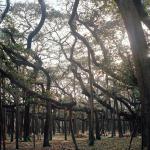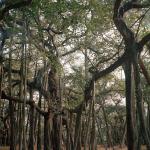. .
The Banyan tree is a symbol for my extended family whose origin is in West Bengal, India. Members of the family up and leave, to drop roots and settle in another place. From there they spread again. Through the same process, a single Banyan tree becomes a whole forest. After 250 years - the age of this tree in Kolkata - you can no longer tell where the beginning was.
In this way the Banyan represents whole diasporas, the spreading of extended families like mine who up and leave a place, to drop roots and settle in another place.
Culturally the Banyan (ficus benghalensis) even belongs to the state where my family comes from, West Bengal, in India, and has associations with religious / spiritual life. The Banyan recurs all over India and its form is immediately recognisable. The tree is sacred and a place of shelter.
The Banyan tree extends its own boundary, and crosses other boundaries to do so. Experimenting with boundaries is important in balancing cultures, (east-west, new-old); or dealing with the unification of different systems (for instance (western) science and (eastern) religion).
My own need to check for balance is largely caused by growing up in a country other than that of my family's background, and being encouraged by my parents to take the best of both worlds. I constantly check my actions in relation to the culture I live in and the culture I come from, and if it makes sense in those contexts.
.
Sujata Majumdar (London, 1976).B Sujatabs artistic endeavour emerges from her need to reconcile the different sides of herself. This arises from her background in different cultures (living in the Netherlands, she is British-Asian - born in England to Indian parents), and her study of science as well as art. Through photography she is seeking a balance between Eastern and Western cultures, natural and man-made landscapes, science and art, and observation and reflection.




